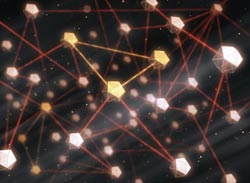Quantum Communication in Random Networks

Illustration of a quantum random network
Internet, networks of connections between Hollywood actors, etc, are examples of complex networks, whose properties have been intensively studied in recent times. The small-world property (that everyone has a few-step connection to celebrities), for instance, is a prominent result derived in this field.
A group of scientists around Professor Cirac, Director at the Max Planck Institute of Quantum Optics (Garching near Munich) and Leader of the Theory Division, has now introduced complex networks in the microscopic, so called, quantum regime (Nature Physics, Advanced Online Publication, DOI:10.1038/NPHYS1665).
The scientists have proven that these quantum complex networks have surprising properties: even in a very weakly connected quantum network, performing some measurements and other simple quantum operations allows to generate arbitrary graphs of connections that are otherwise impossible in their classical counterparts.
The behaviour of networks has been widely explored in the context of classical statistical mechanics. Periodic networks, by definition, have a regular structure, in which each node is connected to a constant number of ‘geometrical’ neighbours. If one tries to enlarge these systems, their topology is not altered since the unit cell is just repeated ad aeternum. The construction of a random network is completely different: each node has a small probability of being connected to any other node. Depending on the connection probability and in the limit of infinite size, such networks exhibit some typical effects. For instance, if this probability is high enough, nearly all nodes will be part of one giant cluster; if it is too small only sparse groups of connected nodes will be present.
In a quantum network one link between neighbouring nodes is given by one pair of entangled qubits, for example atoms; in other words, one link in a quantum network represents the entanglement between two qubits. Therefore, a node possesses exactly one qubit for each neighbour, and since it can act on these qubits it is called a ‘station’. This holds for any kind of quantum networks. However, there are different ways of defining the entanglement between neighbouring qubits. Until now, quantum networks have been mostly modelled as periodically structured graphs, that is, lattices. In the work described here the scientists set the amount of entanglement between two nodes to be equal to the connection probability of the classical random graphs.
In the classical case, some specific subgraphs appear suddenly if one lets the connection probability scale with the size of the network: for very low probabilities only trivial connections (simple links) are present in the network, whereas for higher probabilities the subgraphs become more and more complex (e.g., triangles, squares, or stars). In quantum networks, on the other hand, a qualitatively different behaviour emerges: even for the lowest non-trivial connection probability, i.e., if the entanglement between the nodes is, at first sight, just sufficient to get simple connections, it is in fact possible to generate communication subgraphs of any complexity. This result mainly relies on the superposition principle and on the ability to coherently manipulate the qubits at the stations.
“In our article we want to point out that networks with a disordered structure and not periodic lattices have to be studied in the context of quantum communication”, says Sébastien Perseguers, who has worked on this topic in the frame of his doctoral thesis. “In fact, it is well known that real-world communication networks have a complex topology, and we may predict that this will also be the case for quantum networks. Furthermore, we want to emphasize the fact that the best results are obtained if one ‘thinks quantumly’ not only at the connection scale, but also from a global network perspective. In this respect, it is essential to deepen our knowledge of multipartite entanglement, that is, entanglement shared between more than two particles.” In the future the scientists are going to extend their model to networks of a richer structure, the so-called complex networks which describe a wide variety of systems in nature and society, and they expect to find many new and unexpected phenomena. Sébastien Perseguers/Olivia Meyer-Streng
Original Publication:
S. Perseguers, M. Lewenstein, A. Acín and J.I. Cirac
Quantum random networks
Nature Physics, Advanced Online Publication, DOI:10.1038/NPHYS1665
Contact:
Prof. Dr. Ignacio Cirac
Honorary Professor, Technische Universität München
Max Planck Institute of Quantum Optics
Hans-Kopfermann-Straße 1
85748 Garching
Phone: +49 – 89 / 32905 705 / 736
Fax: +49 – 89 / 32905 336
E-mail: ignacio.cirac@mpq.mpg.de
Sébastien Perseguers
Max Planck Institute of Quantum Optics
Phone: +49 – 89 / 32905 345
Fax: +49 – 89 / 32905 336
E-mail: sebastien.perseguers@mpq.mpg.de
Media Contact
All latest news from the category: Physics and Astronomy
This area deals with the fundamental laws and building blocks of nature and how they interact, the properties and the behavior of matter, and research into space and time and their structures.
innovations-report provides in-depth reports and articles on subjects such as astrophysics, laser technologies, nuclear, quantum, particle and solid-state physics, nanotechnologies, planetary research and findings (Mars, Venus) and developments related to the Hubble Telescope.
Newest articles

Trotting robots reveal emergence of animal gait transitions
A four-legged robot trained with machine learning by EPFL researchers has learned to avoid falls by spontaneously switching between walking, trotting, and pronking – a milestone for roboticists as well…

Innovation promises to prevent power pole-top fires
Engineers in Australia have found a new way to make power-pole insulators resistant to fire and electrical sparking, promising to prevent dangerous pole-top fires and reduce blackouts. Pole-top fires pose…

Possible alternative to antibiotics produced by bacteria
Antibacterial substance from staphylococci discovered with new mechanism of action against natural competitors. Many bacteria produce substances to gain an advantage over competitors in their highly competitive natural environment. Researchers…





















